I awaken. Am I alive? The temperature is neither extremely hot nor extremely cold, so I’m apparently not in some punishment-afterlife. And there’s no beer volcano or stripper-factory, so this obviously isn’t heaven. On the other hand, I am experiencing the usual persistent discomfort involved with waking up early in the morning. On the assumption that Catholic “purgatory” would be more dull, I will assume I am still alive, and had better get up and get to class.
Since my previous experiment, I have obviously had to revise my original hypothesis. Since the last caused me no ill effects, I had to abandon the notion that expired gelatin products become a deadly poison. Instead, as I consume this batch of official, non-sugarless Jell-O®-brand Gelatin (Lime flavored), I operate on a new hypothesis:
“Expired instant gelatin products from intact packaging will not harm me if I eat it.”

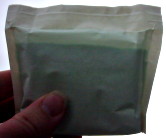 My precious stock of expired JellO® is depleted by one more box, the packet ripped from its cardboard sarcophagus, the contents prepared according to the standard instructions, and consumed hastily last night (the animation from the previous post is the actual container of prepared Lime JellO® made from digital photographs taken between helpings.). You can see the old-style date code on the box. According to Carolyn Wyman’s “JELL-O: A Biography”, the code indicates that it was packaged in 2003 (the “3” at the beginning of the code), on the 343rd day of the year, in the San Leandro (California) packaging facility. Although there is no official “expiration date” shown, given the “expected shelf life” of 24 months, this package is approximately 2 years out of date. And I ate it. I appear to have suffered no ill effects. Not even a decent sugar-rush: the entire box contains 320 calories, barely equivalent to a package of Twinkies®. The flavor even appeared to be perfectly normal. Mmmmmm, Lime JellO…
My precious stock of expired JellO® is depleted by one more box, the packet ripped from its cardboard sarcophagus, the contents prepared according to the standard instructions, and consumed hastily last night (the animation from the previous post is the actual container of prepared Lime JellO® made from digital photographs taken between helpings.). You can see the old-style date code on the box. According to Carolyn Wyman’s “JELL-O: A Biography”, the code indicates that it was packaged in 2003 (the “3” at the beginning of the code), on the 343rd day of the year, in the San Leandro (California) packaging facility. Although there is no official “expiration date” shown, given the “expected shelf life” of 24 months, this package is approximately 2 years out of date. And I ate it. I appear to have suffered no ill effects. Not even a decent sugar-rush: the entire box contains 320 calories, barely equivalent to a package of Twinkies®. The flavor even appeared to be perfectly normal. Mmmmmm, Lime JellO…
When I took it out to eat it, I did spot a beautiful if alarming sight, though:
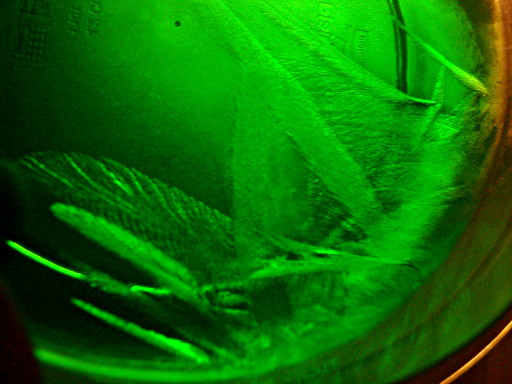
The crystalline-appearing sheets of growth from the edge of the bowl into the gelatin was slightly disturbing. Was I crystallizing something odd out of the gelatin/sugar/flavor solution? The growth resembled infiltration of mold into the gelatin medium enough to slightly worry me. But only slightly.
In fact, as I had most suspected, these turned out to be ice crystals. Quite pretty, but they started slowly melting away after the bowl was allowed to sit at room temperature for fifteen minutes or so – plus, they crunched when I ate them just like ice. Thus encouraged, I ate the gelatin and went to bed. And here I am (sitting in the student lounge between “History of Western Art” and “Introduction to Philosophy”) happily blogging away, apparently unharmed.
Does this prove that expired instant gelatin is harmless? Well, no, not exactly. Scientists never really “prove” anything. Instead, we attempt to “falsify” our hypotheses and theories as best we can. This is where the concept of the “null hypothesis” comes in.
The “Null Hypothesis” here is the situation that, if true, falsifies my hypothesis. In this case, it would be “Expired instant gelatin products from intact packaging will harm me if I eat it.”. However, I did eat expired gelatin products from an intact package and was NOT harmed. Therefore I must “reject the Null Hypothesis”…and therefore my experimental evidence does not fail to support my hypothesis! SUCCESS!
If we are unable to find a condition which renders our hypothesis or theory incorrect after many and varied tests, ideally by several different researchers, then we can be confident that our hypothesis or theory is correct, but we don’t necessarily KNOW that there isn’t some odd undiscovered exception that we don’t know about.
Two samples (this one and the previous sugarless-orange one) is hardly a large number of trials. This doesn’t prove that expired JellO® is always safe, but since I know of no plausible way by which an intact package of instant gelatin could become hazardous I feel pretty comfortable that expired gelatin from intact packaging won’t harm me.
If the package is not intact and contains a fuzzy green lump instead of the usual powder, then it’s a whole other situation, obviously…
I do still have three or four more boxes of the sugarless generic expired gelatin – perhaps I can come up with some more tests. Meanwhile, I do hope that my incredibly brave, life-threatening experiments here will relax nervous expired-JellO eaters everywhere…
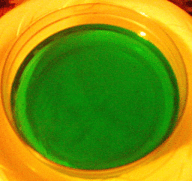 “Now I lay me down to bed
“Now I lay me down to bed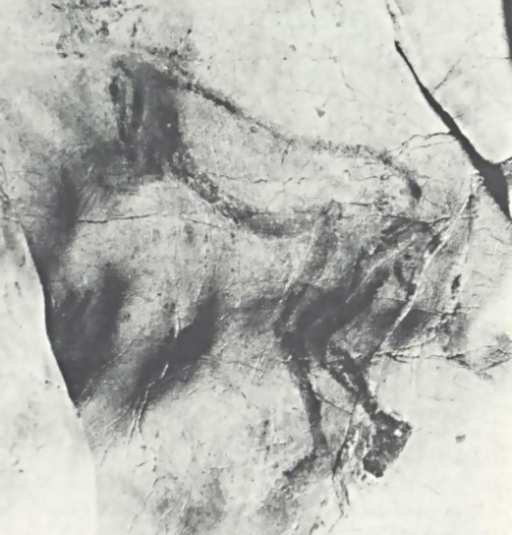
 Okay…to me the “head” looks like an indistinct smear, with spots that a human mind – tuned to recognize patterns, especially faces, even if the patterns don’t actually exist – might interpret as some kind of face. To me, it looks kind of like a crudely-drawn cartoon-animal face, with overwhelmed-Charlie-Brown-style bugeyes, a button nose, and the tongue hanging out of one side of its mouth. Yet, somehow, I don’t feel inclined to suggest that this is what is actually there. Personally, I’d be more inclined to suspect that the artist (estimated to have lived 13000-15000 years ago) had trouble finishing the drawing and gave up. Yet if you poke around for information about this image, you find all kinds of breathless prose about it. So, where does all the poetic language about the possible “meaning” and interpretation of the Trois-Frčres “Sorcerer” come from?
Okay…to me the “head” looks like an indistinct smear, with spots that a human mind – tuned to recognize patterns, especially faces, even if the patterns don’t actually exist – might interpret as some kind of face. To me, it looks kind of like a crudely-drawn cartoon-animal face, with overwhelmed-Charlie-Brown-style bugeyes, a button nose, and the tongue hanging out of one side of its mouth. Yet, somehow, I don’t feel inclined to suggest that this is what is actually there. Personally, I’d be more inclined to suspect that the artist (estimated to have lived 13000-15000 years ago) had trouble finishing the drawing and gave up. Yet if you poke around for information about this image, you find all kinds of breathless prose about it. So, where does all the poetic language about the possible “meaning” and interpretation of the Trois-Frčres “Sorcerer” come from?
 Expired JellO®! Deadly Poison, or Merely Debilitating? Can a human being withstand the toxic load of an *entire box* of it? Would he suffer embarassingly loud and messy gastrointestinal distress, or would immediate organ failure set in before this could take place? STAY TUNED TO FIND OUT!…
Expired JellO®! Deadly Poison, or Merely Debilitating? Can a human being withstand the toxic load of an *entire box* of it? Would he suffer embarassingly loud and messy gastrointestinal distress, or would immediate organ failure set in before this could take place? STAY TUNED TO FIND OUT!…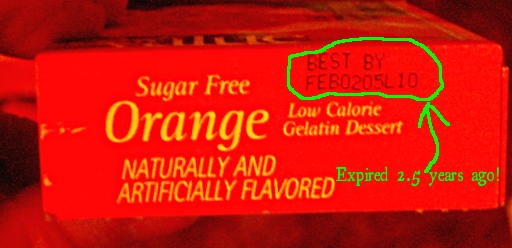
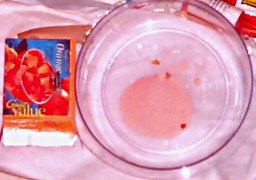 Last night, I plucked from the depths of my pantry an expired-2˝-years-ago box of sugarless orange-flavored gelatin with which to begin this investigation. I blew the layer of dust off of the box, and carefully opened it, half-expecting to find some strange mutant gelatin-beast had developed in it over the years since expiration. One hand poised to protect myself should the creature leap from the box to eat my face in anger of being disturbed, I was both relieved and slightly disappointed to find nothing more than a foil packet containing what sounded like perfectly ordinary gelatin-powder. The packet proved to be intact, and the happy orange powder poured into a freshly-cleaned dish in a manner perfectly imitating that of wholesome non-expired gelatin. I dismissed the faint demonic snickering sound I seemed to hear as a figment of my fevered imagination and prepared the gelatin powder in the usual manner.
Last night, I plucked from the depths of my pantry an expired-2˝-years-ago box of sugarless orange-flavored gelatin with which to begin this investigation. I blew the layer of dust off of the box, and carefully opened it, half-expecting to find some strange mutant gelatin-beast had developed in it over the years since expiration. One hand poised to protect myself should the creature leap from the box to eat my face in anger of being disturbed, I was both relieved and slightly disappointed to find nothing more than a foil packet containing what sounded like perfectly ordinary gelatin-powder. The packet proved to be intact, and the happy orange powder poured into a freshly-cleaned dish in a manner perfectly imitating that of wholesome non-expired gelatin. I dismissed the faint demonic snickering sound I seemed to hear as a figment of my fevered imagination and prepared the gelatin powder in the usual manner.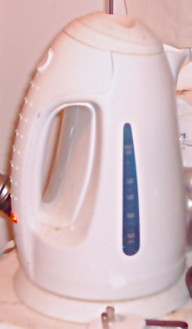 I took up my electric kettle, containing distilled water, and threw the switch. Seconds passed into minutes. Minutes passed into more minutes. Then, the water began boiling vigorously, and I applied one cup (8 fluid ounces) of this to the dish of powder, stirring it with a tablespoon. It seemed to take at least two minutes of continuous stirring, but the deceptively innocent-looking powder finally dissolved without the slightest scent of brimstone. As prescribed by the instructions on the box, I added a further 8 fluid ounces of cold water (from the tap of my kitchen sink), stirred briefly to mix, and placed the dish in the refrigerator to gel overnight.
I took up my electric kettle, containing distilled water, and threw the switch. Seconds passed into minutes. Minutes passed into more minutes. Then, the water began boiling vigorously, and I applied one cup (8 fluid ounces) of this to the dish of powder, stirring it with a tablespoon. It seemed to take at least two minutes of continuous stirring, but the deceptively innocent-looking powder finally dissolved without the slightest scent of brimstone. As prescribed by the instructions on the box, I added a further 8 fluid ounces of cold water (from the tap of my kitchen sink), stirred briefly to mix, and placed the dish in the refrigerator to gel overnight.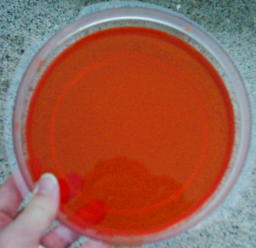 Day broke, and this very afternoon I took the now solidified mass from the refrigerator. This was it. My last chance to avoid whatever hellish abuses this disturbingly orange substance had planned for me. But no…it was far too late to turn back now. I took up my spoon, and devoured every last bit of happy orange jiggliness.
Day broke, and this very afternoon I took the now solidified mass from the refrigerator. This was it. My last chance to avoid whatever hellish abuses this disturbingly orange substance had planned for me. But no…it was far too late to turn back now. I took up my spoon, and devoured every last bit of happy orange jiggliness.
 I always find it interesting to go back and see the earlier stages of scientific endeavors – especially as relates to my own interests. There always seem to be things that have since been forgotten, abandoned, or glossed over in them.
I always find it interesting to go back and see the earlier stages of scientific endeavors – especially as relates to my own interests. There always seem to be things that have since been forgotten, abandoned, or glossed over in them. H.W. Conn seems to have been most interested in dairy microbiology, so there is a substantial amount of space devoted to it. I’ve heard of “blue milk” before (Yummy!….Pseudomonas?), but not Red or Yellow milk. He also devotes space to discussing the affect of “good” (and “bad”) bacterial cultures on butter, cream, and cheeses. I’m not even sure if butter is cultured these days, or if they just churn it up fresh and cold with minimal growth. Dangit, one of these days we’re just going to have to move somewhere we can keep a miniature dairy cow so I can do some experimentation with real unpasteurized fresh milk.
H.W. Conn seems to have been most interested in dairy microbiology, so there is a substantial amount of space devoted to it. I’ve heard of “blue milk” before (Yummy!….Pseudomonas?), but not Red or Yellow milk. He also devotes space to discussing the affect of “good” (and “bad”) bacterial cultures on butter, cream, and cheeses. I’m not even sure if butter is cultured these days, or if they just churn it up fresh and cold with minimal growth. Dangit, one of these days we’re just going to have to move somewhere we can keep a miniature dairy cow so I can do some experimentation with real unpasteurized fresh milk.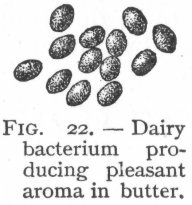 Bacterial phylogeny was so quaint back then. “Bacillus acidi lacti.” Ha! I love it. Interestingly, the term “Schizomycete” doesn’t appear anywhere in the text, though that may or may not be because it was considered unnecessarily technical for the intended audience. There’s actually very little about microbiological methods, too, which is the one major disappointment for me. Oh well, still interesting stuff. Conn actually mentions various “industrial” uses of bacteria including retting (soaking fibrous plants like flax or hemp so that bacteria eat the softer plant material to free the fibers), the roles of different bacterial cultures in curing tobacco, and even a fermentation in the production of opium (which Conn says is fungal rather than bacterial).
Bacterial phylogeny was so quaint back then. “Bacillus acidi lacti.” Ha! I love it. Interestingly, the term “Schizomycete” doesn’t appear anywhere in the text, though that may or may not be because it was considered unnecessarily technical for the intended audience. There’s actually very little about microbiological methods, too, which is the one major disappointment for me. Oh well, still interesting stuff. Conn actually mentions various “industrial” uses of bacteria including retting (soaking fibrous plants like flax or hemp so that bacteria eat the softer plant material to free the fibers), the roles of different bacterial cultures in curing tobacco, and even a fermentation in the production of opium (which Conn says is fungal rather than bacterial).